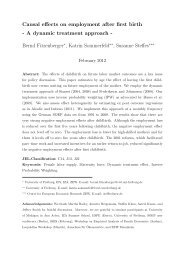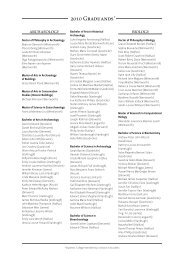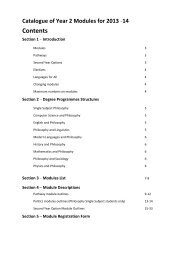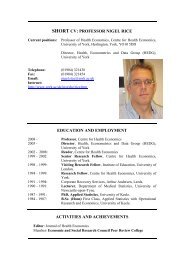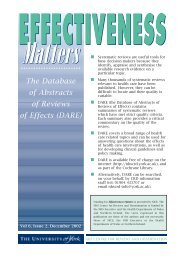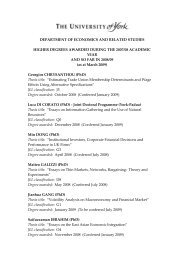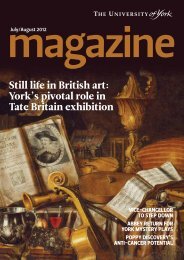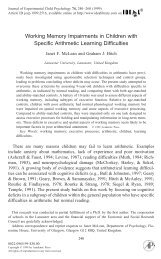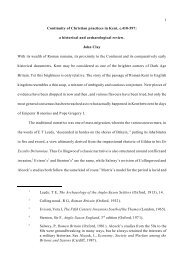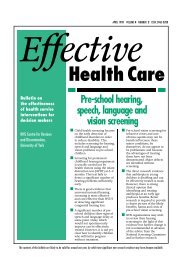GeloriniPhD (PDF , 6973kb) - University of York
GeloriniPhD (PDF , 6973kb) - University of York
GeloriniPhD (PDF , 6973kb) - University of York
You also want an ePaper? Increase the reach of your titles
YUMPU automatically turns print PDFs into web optimized ePapers that Google loves.
1.3.1. Descriptions and illustrations <strong>of</strong> African fungal spore types<br />
Type HdV-89: Tetraploa aristata Berk. & Broome (van Geel, 1978) (Plate I; Fig. 1.2)<br />
. 47 .<br />
CHAPTER 1<br />
Diversity and ecology <strong>of</strong> tropical African fungal spores<br />
Conidia verrucose, muriform, 4 columns <strong>of</strong> cells terminating in septate setiform appendages. Tetraploa aristata is known<br />
from many locations worldwide, mainly in subtropical and tropical regions but also in the temperate climatic zone. It is<br />
found on a variety <strong>of</strong> host plants, usually on leaf bases and stems just above the soil (Ellis, 1971; Farr and Rossman, 2009).<br />
Type HdV-113: Sporormiella type (van Geel et al., 2003) (Plate I; Fig. 1.2)<br />
Ascospores <strong>of</strong> modern-day Sporormiella species are three- to multi-septate. Each ascospore cell shows an oblique<br />
to diagonal germ slit, extending over the entire length <strong>of</strong> the cell. The ascospores easily split up in separate cells,<br />
consequently in the fossil state usually no complete ascospores are found. Identification <strong>of</strong> Sporormiella and similar<br />
genera to the species level is not possible because fruit-bodies, asci and complete ascospores are not available (Ahmed<br />
and Cain, 1972). Representatives <strong>of</strong> the related genus Sporormia lack germ slits, but as the descriptions <strong>of</strong> Ahmed and<br />
Cain (1972) are based on non-germinated spores, a slit may appear after germination, and thus we cannot exclude<br />
that our fossil assemblages also include Sporormia (van Geel and Aptroot, 2006). Both Sporormia and Sporormiella are<br />
coprophilous fungi, <strong>of</strong>ten associated with the dung <strong>of</strong> large herbivores (Comandini and Rinaldi, 2004). Fossil Sporormiellalike<br />
part-spores were distinguished by Davis et al. (1977), Davis and Turner (1986), Davis (1987), Burney et al. (2003), and<br />
van Geel et al. (2003). The spores are considered to be a reliable proxy for large herbivore populations occurring near the<br />
site <strong>of</strong> recovery (Burney et al., 2003). Sporormiella type spore cells <strong>of</strong> variable size (10-16 µm) are common throughout<br />
the Lake Challa record.<br />
Type HdV-172: Coniochaeta cf. ligniaria (Greville) Massee (van Geel et al., 1983a) (Plate I; Fig. 1.2)<br />
Ascospores circular to ellipsoid in outline, 14-20 x 11-15 µm, one-celled, bilaterally flattened, the two flattened dark<br />
brown sides have a light brown zone encircling the spore. A germ slit is present along the narrow side in the light brown<br />
zone. Jarzen and Elsik (1986) described and illustrated similar spores from river deposits in Zambia as Exesisporites.<br />
According to Munk (1957), C. ligniaria is common on dung and wood (see also Farr and Rossman, 2009). Ascospores<br />
<strong>of</strong> this species were found in soil surface samples from a Roman Period settlement site with strong evidence for a high<br />
density <strong>of</strong> domesticated animals (van Geel et al., 2003; van Geel and Aptroot, 2006). This Type is common throughout the<br />
Challa record, particularly during the Holocene.<br />
Type HdV-1001: Caryospora sp. (Plate I)<br />
Ascospores 3-septate, apiculate, bigger cells dark brown, smaller cells light brown, ca. 50 x 28 µm. Caryospora species<br />
occur on dead plant material (Barr, 1979). Only one specimen was found in the Challa record (in the full-Glacial section).<br />
Type HdV-1004 (Plate I)<br />
Fungal spores (conidia?) cylindrical with rounded end cells, 3-5 septate, ca. 24-31 x 10 µm. Small pore in end cells. Rare<br />
in the Challa record; all 4 specimens were found in the full-Glacial section.



